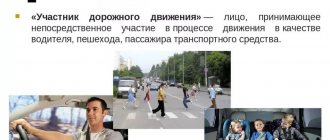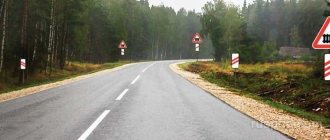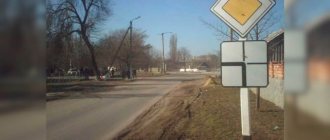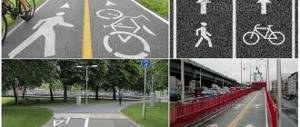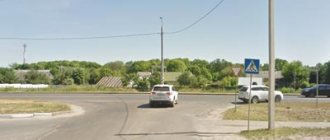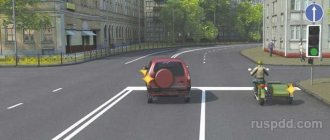In today’s article we will discuss the “Main Road” sign (2.1), which raises many questions among both beginners and motorists with decent driving experience. As a rule, the most difficult thing for them is to figure out exactly how a given sign works in places where the road changes its direction, and also to determine where its coverage area ends. We will consider these and some other topics related to the mentioned sign in more detail.
Which section of the road is indicated by sign 2.1
The "Main Road" sign is one of those that indicate priority. It is installed on a road that has an advantage over the roadway crossing it. And they do this, as a rule, in places where the intersection is not regulated, or there is an entrance from such a section of the road to the intersection.
In other words, the sign described determines the order of crossing through an uncontrolled intersection (by the way, the traffic light and the traffic controller cancel the effect of this sign). An additional sign (8.13) can be installed underneath it, indicating in which direction the main road goes, and the driver must take this into account to set the order of crossing the intersection.
Priority signs
Since the road sign indicating the main road is in the group of priority ones, it would be useful to understand what their essence is. The group is relatively small, but at the same time it has no less importance in traffic rules than a warning one.
Which signs are priority:
- Main road – defines the area where the right of way is provided. Used at intersections without regulation.
- End of main road sign – used to indicate the end of the main road.
- Intersection with a minor road – informs you about the intersection of your road with a minor road at the next intersection.
- Junction of a secondary road - its meaning coincides with the previous sign. The difference lies in the adjoining of the road to yours from one of the directions.
- Give way - at an uncontrolled intersection you must not interfere with the movement of motorists moving along the main road.
- Driving without stopping is prohibited - analogous to the sign of giving way. Requires you to stop before crossing an intersection.
- The advantage of oncoming traffic is that it is installed on narrow parts of roads. The sign requires you to give way to motorists in the oncoming lane.
- Advantage over oncoming traffic, on the contrary, provides the right of passage on a narrowed road. But if oncoming cars have already entered the lane, you need to let them pass.
This is a complete list of priority signs that motorists need to know. They do not prohibit, but give instructions for action.
Now let's take a closer look at what a secondary and main road is, and how to understand the sign that marks it.
What does a sign indicating a main road look like?
The road on which you must yield to traffic is indicated by a sign in the form of a yellow diamond in a white frame. The “Main Road” sign has this shape for a reason; it has no analogue, so the sign is easy to spot at any section of the intersection, even from the rear side. And this will help the driver correctly determine the order of passage through a difficult section of the road.
For greater safety, experienced drivers are advised to slow down when approaching an intersection and carefully examine its right corner. If there is no sign, look at the left corner, which is located closer to the person driving, and then at the one further away. This will help you accurately navigate and understand whether you should give way.
How can you determine which road is the main one if the sign is not installed?
In every locality, the “Main Road” sign, a photo of which you can see in this article, is installed in front of intersections. But let's also clarify how you can determine the main road if this sign is not there?
In such cases, both the road surface and the location of adjacent roads will help you out. Only the one with a hard surface in relation to the unpaved ones, or the one that is adjacent to exits from nearby territories, will receive the main status.
By the way, keep in mind that even if there is a pavement on the secondary road in the area adjacent to the intersection, it still does not become equal in importance to the one that crosses it.
the main road
Now let's talk about what this sign means and what advantages it provides to the motorist.
What is considered the main road?
We can consider the main road to be that section of the road that is located behind mark 2.1 to the first intersection along the way.
However, the rules also state that the main road is any paved roadway in relation to the adjacent dirt road. In this case, placing a sign defining priority is not necessary.
How to behave on the main road?
You need to remember that on this section of the road you have an advantage over those moving on secondary roadways. However, this does not mean that you need to rush headlong, knowing about your advantage, ramming everyone and everything.
Sign installation location
The “Main Road” road sign is placed taking into account the distance to the place where it begins to operate. That is, this sign can be installed immediately before the intersection, which will be subject to this restriction.
Before all intersections, the described priority sign is repeated. This precaution is necessary due to the peculiarities of the operation of the signs “Give way” (2.4), “Intersection ...” (2.3.1) or “Adjacent to a secondary road” (2.3.2 - 2.3.7), installed before leaving adjacent side streets. All of the listed signs do not inform that the road being crossed is the main one, but only require you to give way with or without a mandatory stop. In order to supplement the information, sign 2.1 is duplicated.
By the way, instead of the once again repeated “Main Road” sign, one of the varieties of the “Adjacent to the Main Road” sign is sometimes used. But taking into account the fact that it is installed not directly in front of the intersection, but at a distance from it, this is quite difficult to do in urban conditions. Therefore, this combination is used more often not in populated areas, but behind them.
Signs on minor roads
To warn drivers that they are driving on a secondary road and are approaching an intersection with the main road, they put up a “Give way” sign (2.4). Place it before exiting the main road at the beginning of the junction, before an intersection or exit onto a highway. Additionally, with 2.4, plate 8.13 can be used, informing about the direction of the main road in the section being crossed.
Before the intersection with the main road, sign 2.5 may be placed, which prohibits passing without stopping. 2.5 obliges you to yield to vehicles traveling on the roadway you are crossing. Drivers must stop at the stop line, and when there is none, at the border of the intersection. Only after making sure that further movement is safe and does not interfere with transport in the direction being crossed can you move off.
Area of operation of the "Main Road" sign
In populated areas, by the way, duplication of this sign is required before each intersection also because in fact it does not have any coverage area other than the installation location, because it suggests priorities only at the intersection where it is located.
If the sign is installed at the beginning of the road (namely behind the intersection), then its effect is extended to the entire section of the road. And where the road ceases to be the main one, sign 2.2 is installed indicating this. By the way, remember that this sign does not immediately turn the road into a secondary one, it makes it clear that in front of you there is an intersection of equivalent roads.
Intersection with a secondary road
The sign “Intersection with a minor road” indicates to the driver that at the next intersection the main road will intersect with a secondary road. At the same time, the sign shows where the main and secondary roads are located, and also provides an advantage when passing through an unregulated intersection.
Sign "Intersection with a secondary road"
How does the “Main Road Changes Direction” sign work?
If there is no sign under the sign, it means the priority road is going straight ahead. In cases where its direction changes, an additional sign is installed.
As experienced drivers confirm, it is most difficult to plan your actions at those intersections where the direction of the main road changes. This section of roads combines problems of two types: the intersection of equivalent and unequal intersections. And the main mistake of motorists in such cases is that they take into account only those signs that they see, without thinking about other corners of a given intersection (we have already discussed this above).
Imagine the situation when you are at an intersection with a changing direction of the priority road. Both you and the driver standing, for example, on the right before the intersection, see the same “Main Road” sign, which gives you priority in traffic! And this is usually discovered only later, after the accident! So what is the right way to act in such conditions?
Algorithm for driver action in case of changes in the direction of the priority road at an intersection
- When at such an intersection, do not forget to think about all its sides and be sure to take into account sign 8.13, which will show the direction of the main road.
- You can mentally place this sign in the center of the intersection, and then a wide line will show the main road, and two narrow lines will show the secondary ones.
- Having temporarily erased the secondary ones from your consciousness, you must remember the main area. Then both you and the driver on the other half of the main road must act according to the “Interference on the right” rule.
- Naturally, the one who does not have such an obstacle will move first.
- And only after the cars leave the main area, the vehicles on the secondary roads begin to move according to the same pattern.
Please note that in this way a difficult intersection can be divided into two symmetrical and easy-to-traverse halves.
External designation
In accordance with the traffic rules, sign 2.1 looks like a yellow diamond with a white outline around the edge. The designation is often used on the roads and is known to all drivers.
Sign 2.2 “End of the main road” Sign 2.1 “Main road”
Installing a road sign on a highway gives priority to all cars moving along it. Vehicles entering such a lane from a secondary direction give way.
The process for determining travel priority depends on:
- Availability of technical regulation at the intersection. The traffic light cancels the priority signs. Drivers must comply with the signal. Otherwise, there is a high probability of an accident.
- View of road sign 8.13, which determines the direction of the main route. Installed before an intersection. The picture schematically shows the intersection of two roads. The main direction is indicated by a thick line. Outside the populated area it is located at a distance of 150 – 300 meters before the intersection. The same markings are used on roundabouts, indicating which exits are major and which are minor.
- If the turn on the priority route does not have 90 degrees, then in the photo an additional clarification is placed at the same angle. The presence of a sign always indicates that the direction of the main road will change. When driving through such an intersection, you must make sure that other drivers give way.
- The end of the priority direction. In such a place there is a sign for the end of the main road. Externally, it is made in the shape of a yellow diamond, which is crossed out by several closely spaced thin lines passing through the center. The subsequent intersection is considered equivalent. To determine priority, the right obstacle rule is applied, or the type of road surface is used. An asphalt (concrete-cement, stone) road has an advantage over a dirt road.
- Sign at the exit to the main road. When driving in a secondary lane, a “Give Way” sign is placed at the intersection. Made in the shape of an inverted triangle in white with a red outline along the edge of the figure. May be accompanied by an 8.13 sign indicating the further direction of the main lane to the driver. Arrows are also installed indicating one-way traffic and its direction.
Sign violation
Remember also that if the driver violates the requirements of a road sign, namely, by failing to give priority to a car at an intersection, such actions are qualified in accordance with Article 12.13 of the Code of Administrative Offenses of the Russian Federation and are punishable by a fine of 1,000 rubles. And in case of driving where it was prohibited without stopping, the driver is punished under Art. 12.16 Code of Administrative Offenses of the Russian Federation with a warning, or he will be fined in the amount of 500 rubles.
Get yourself a table of traffic police fines, which will give you the opportunity to navigate the degree of punishment for any violations of the rules.
Advice for those who enter an intersection on what is considered the main road
And finally, I would like to convey to those who approached the intersection, having passed the “Main Road” sign: please note that drivers who are at that moment on a secondary road do not remember the rules of the road!
Don't forget this for a minute and don't try to cross the intersection right away. First, stop and make sure that they are giving way to you, and only after understanding this, continue moving. Only this attitude towards the road will make your journey safe, and you will successfully and without incident get to where you were in a hurry.
